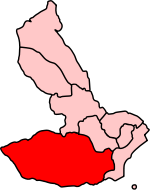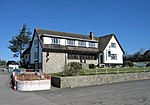Walterston
Glamorgan geography stubsVillages in the Vale of Glamorgan

Walterston (Welsh: Tre-walter) is a small farming hamlet just north of Barry in the Vale of Glamorgan in South Wales and west of Dyffryn. Walterston lies just to west of the Five Mile Lane leading down to Waycock Cross, Barry. The hamlet is very small and has just a few farms, all of which are twelfth to thirteenth century in origin. There are also several houses of which the two largest are the thatched 'Walterston Fach' and its neighbouring 'Trewalter Fawr'. The old monastic village of Llancarfan lies a further two miles to the west.
Excerpt from the Wikipedia article Walterston (License: CC BY-SA 3.0, Authors, Images).Walterston
A4226,
Geographical coordinates (GPS) Address Nearby Places Show on map
Geographical coordinates (GPS)
| Latitude | Longitude |
|---|---|
| N 51.431948 ° | E -3.340492 ° |
Address
Y Daith
A4226
CF62 3AB , Llancarfan
Wales, United Kingdom
Open on Google Maps









